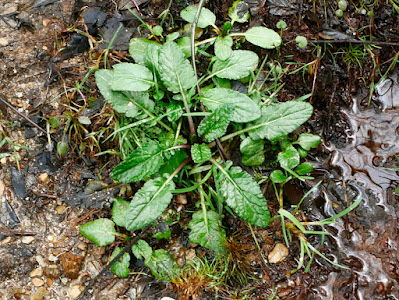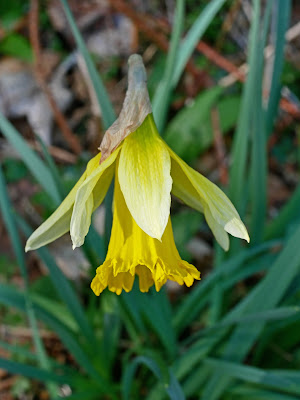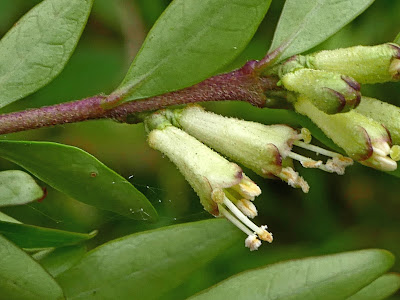As I write this on the 20th March, it has rained almost every day for most of the year so far. It's certainly the wettest early year period I can recall. As such, I haven't gone out that much, so this is a short blog on botanical finds or plants of interest found so far. With the rain has been very mild weather, with only two short periods of frost to date. As such, many Spring plants are coming into flower earlier than usual by up to two weeks or so. The wet and mild weather should also bode well for annual species in the coming weeks and should enable them to recover from the repeated Spring droughts we have had in recent years.
Here are the plants I've come across so far this March, many being rosettes or plants without flowers. If you record, it's important to try and identify plants in this state too. Plants may be present all or much of the year, but may be in flower just for a few weeks, so why restrict yourself to only identifying plants in flower?
My first plant actually was in flower and is a plant of acidic bogs and mires, Round-leaved Water Crowfoot. I found it at Retire Common, not far from Bodmin. The habitat where it grows in is usually in or by the stream that runs through the common or in pools where the water collects. However, it has been so wet this year, that seeds have germinated on the footpath through the common and the plant below (and many others) were in water filled footprints on the main path. The stream itself was full of these plants too. They've only just begun to flower, so in a couple of weeks, there should be drifts of flowers here.
Ranunculus omiophyllus
Another bog plant that was growing all over the place was Marsh Ragwort. Like the Crowfoot above, it had multiple plants growing on the path as well as by the stream where it is usually found. Of course, it was too early for flowers, so here's a photo of it's basal leaves. Note the very large terminal lobe and simple side lobes that distinguish it from other Ragworts.
Jacobaea aquatica
Opposite Leaved Golden Saxifrage is a reliable early Spring flower to find. In Cornwall it's found almost everywhere there is flowing water or seepage, from rock fissures to road edges, streams and rivulets. These were some of the first to come into flower, but now there are thousands of golden little dots amongst carpets of plants. It's always a wonderful and uplifting sight to see them in flower in early Spring.
Chrysosplenium oppositifolium
From late February onwards, I see lots of young Common Valerian plants. These are fairly common on Cornish hedges and woodland paths in Cornwall. However, back in Kent, they are very uncommon and were only found on dry chalk slopes, often in company with the likes of Musk and Common Spotted Orchids. It's odd how the plant has adapted to such different environments, but then, there are two subspecies and these are found in these two very different environments, but not usually together.
The chalk tolerant subspecies is called subsp. collina and the acidic tolerant one found in Cornwall is called subsp. sambucifolia. They are separated by having a different arrangement for their stem leaves. You might find both subsp. together in some places, so it's always worth checking the stem leaves if you are going to identify them to subspecies level and not solely relying on its environmental habitat.
The plant below will grow up to a metre tall with at least three pom pom like heads of small pink/white flowers later in the year, all being well.
Valeriana officinalis
In Kent, Green Hellebore was considered a native plant and was included in the rare plant register and it was always great to find some. In Cornwall, they are considered neophytes and arrived within the last few hundred years by human intervention, usually as garden escapes. Having said that, the plants I have seen in Cornwall have fully naturalised. The plants below were first recorded in the wild at this location in 1927, almost a century ago. There are now well over 100 plants along a rural lane Cornish hedge and extended several metres into deciduous woodland, so they have survived here a long time.
Helleborus viridis subsp occidentalis
Here's one of the clumps in the woodland spread quite a distance from the original introduction.
A flower close up.
Wandering the lanes and by-ways of Cornwall, one never quite knows what exotic plant might turn up next. In this case, I came across several large Tree Ferns, similar to those found at Helligan Gardens. In this case, it was clear they had been planted as they were all in a straight line along a farm track. However, they are not cheap to buy and I wondered why someone would pay out all that money to plant them along a farm access road, a long way from the farmhouse or any other buildings. I put in a record for these as planted, as there are records of some growing wild in Cornwall, so should some be found growing wild nearby in years to come, they will know where they originated from by my record.
Dicksonia antarctica
Plenty of Scarlet Elf Cup fungi were now growing on the wet dead wood in several locations I visited. The wet weather meant there were lots more around than I saw last year.
Sarcoscypha coccinea
My partner and I had lunch at a coastal pub at Trebarwith Strand and I noticed lots of these pale green rosettes, growing on a vertical wall with fresh water seepage constantly running over them. I recognised them as Brookweed, often found in such damp coastal locations here. Sea Spleenwort grew with them too.
Samolus valerandi
Some of the other species that had come into flower so far this month incuded:
Barren Strawberry - Potentilla sterilis
Wild Strawberry - Fragaria vesca
Lesser Celandine - Ficaria verna
Wild Daffodil - Narcissus pseudonarcissus subsp pseudonarcissus
Greater Stitchwort - Stellaria holostea
Blackthorn - Prunus spinosa
Danish Scurvygrass - Cochlearia danica
I'll end with a Dandelion. It's that time of year when they start to become identifable again. The one below that I found at Looe seafront had spotted leaves, a Section Naevosa species which I had determined by the referee as:
Taraxacum ronae
There were of course many more species coming into flower than I have featured, along with many pavement plants, such as Rue-leaved Saxifrage and Common Whitlowgrass, but I won't feature them all. As increased daylight continues into April, there will be many more species to see, and I am looking forward to discovering them all over again along with hopefully, some new species too.
Take Care
Dave








































































